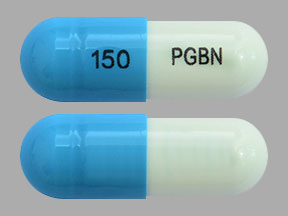Pregabalin Disease Interactions
There are 6 disease interactions with pregabalin.
- Drug dependence
- Suicidal tendency
- Angioedema
- Creatine kinase elevations
- Peripheral edema
- PR interval prolongation
Anxiolytics/sedatives/hypnotics (applies to pregabalin) drug dependence
Major Potential Hazard, Moderate plausibility. Applicable conditions: Drug Abuse/Dependence
Anxiolytic, sedative, and hypnotic agents have the potential to cause dependence and abuse. Tolerance as well as physical and psychological dependence can develop, particularly after prolonged use of excessive dosages, and abrupt cessation and/or a reduction in dosage may precipitate withdrawal symptoms. In patients who have developed tolerance, overdosage can still produce respiratory depression and death. Therapy with anxiolytic, sedative, and hypnotic agents should be administered cautiously and for as brief a period as possible. Addiction-prone individuals, such as those with a history of alcohol or substance abuse, should be under careful surveillance or medical supervision when treated with these agents. In addition, it may be prudent to refrain from dispensing large quantities of medication to such patients. After prolonged use or if dependency is suspected, withdrawal of medication should be undertaken gradually using a dosage-tapering schedule.
Antiepileptics (applies to pregabalin) suicidal tendency
Moderate Potential Hazard, Moderate plausibility. Applicable conditions: Depression, Psychosis
Antiepileptic drugs (AEDs) have been associated with an increased risk of suicidal thoughts or behavior in patients taking these drugs for any indication. Pooled analyses of 199 placebo-controlled clinical studies involving the use of 11 different AEDs showed that patients receiving AEDs had approximately twice the risk of suicidal thinking or behavior compared to patients receiving placebo. AEDs should be administered cautiously in patients with depression or other psychiatric disorders; phentermine-topiramate should be avoided in patients with history of suicidal attempts or active suicidal ideation. The risk of suicidal thoughts and behavior should be carefully assessed against the risk of untreated illness, bearing in mind that epilepsy and many other conditions for which AEDs are prescribed are themselves associated with morbidity and mortality and an increased risk of suicidal thoughts and behavior. Patients, caregivers, and families should be alert to the emergence or worsening of signs and symptoms of depression, any unusual changes in mood or behavior, or the emergence of suicidal thoughts or behavior. If patients have symptoms of suicidal ideation or behavior, a dosage reduction or treatment discontinuation should be considered.
Pregabalin (applies to pregabalin) angioedema
Moderate Potential Hazard, Moderate plausibility.
Angioedema has been reported during pregabalin therapy, including reports of life-threatening angioedema with respiratory compromise requiring emergency treatment. Therapy with pregabalin should be administered cautiously in patients at risk of developing angioedema or those with a previous episode of angioedema.
Pregabalin (applies to pregabalin) creatine kinase elevations
Moderate Potential Hazard, Moderate plausibility. Applicable conditions: Myopathy
The use of pregabalin has been associated with creatine kinase elevations. Use caution when treating patients with diagnosed of suspected myopathy or with significantly elevated creatine kinase levels.
Pregabalin (applies to pregabalin) peripheral edema
Moderate Potential Hazard, Moderate plausibility. Applicable conditions: Congestive Heart Failure
Pregabalin treatment may cause peripheral edema. There are limited data concerning the use of pregabalin in patients with congestive heart failure. Therapy with pregabalin should be administered cautiously in patients with New York Heart Association (NYHA) Class III or IV cardiac status.
Pregabalin (applies to pregabalin) PR interval prolongation
Moderate Potential Hazard, Moderate plausibility. Applicable conditions: Heart Block, Abnormal Electrocardiogram
Pregabalin should be administered cautiously in patients with preexisting conduction abnormalities (e.g., marked first-degree AV block or second- or third-degree AV block), as it has been associated with PR interval prolongation. In a clinical trial, the mean PR interval increase was 3 to 6 msec with pregabalin at doses higher than or equal to 300 mg per day. This mean change difference was not associated with an increased risk of PR increase >=25% from baseline, an increased percentage of subjects with on-treatment PR >200 msec, or an increased risk of adverse reactions of second or third degree AV block. Subgroup analyses did not identify an increased risk of PR prolongation in patients with baseline PR prolongation or in patients taking other PR prolonging medications. However, these analyses cannot be considered definitive because of the limited number of patients in these categories.
Switch to professional interaction data
Pregabalin drug interactions
There are 287 drug interactions with pregabalin.
Pregabalin alcohol/food interactions
There is 1 alcohol/food interaction with pregabalin.
More about pregabalin
- pregabalin consumer information
- Check interactions
- Compare alternatives
- Pricing & coupons
- Reviews (1,687)
- Drug images
- Side effects
- Dosage information
- Patient tips
- During pregnancy
- Support group
- Drug class: gamma-aminobutyric acid analogs
- Breastfeeding
- En español
Related treatment guides
Drug Interaction Classification
| Highly clinically significant. Avoid combinations; the risk of the interaction outweighs the benefit. | |
| Moderately clinically significant. Usually avoid combinations; use it only under special circumstances. | |
| Minimally clinically significant. Minimize risk; assess risk and consider an alternative drug, take steps to circumvent the interaction risk and/or institute a monitoring plan. | |
| No interaction information available. |
See also:
Further information
Always consult your healthcare provider to ensure the information displayed on this page applies to your personal circumstances.


